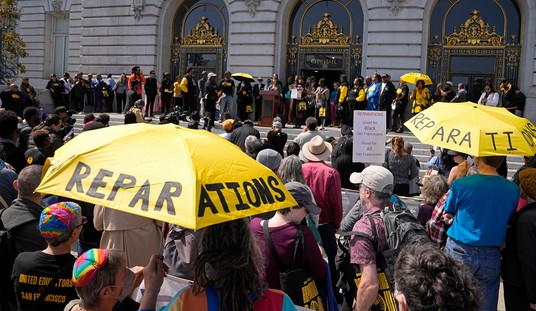The accelerated transformation of the American economy and polity into a mandatory racially-based spoils system was a defining trait of President Barack Obama’s first term in office. Though perhaps understated, it is set to become an even more defining trait of his second.
Obama, by various accounts, wants to be more aggressive about suing banks, employers, schools and other institutions whose practices, however unintentionally, adversely affect “disadvantaged” (read: nonwhite) populations. This is the doctrine of “disparate impact.” Attorney General Eric Holder already has used it to extract hundreds of millions of dollars in coerced settlements from Wells Fargo and other major banks. Its widespread application is further evidence, as if any more were needed, that “civil rights” has become a well-organized shakedown racket.
For too long, whites, including many self-described conservatives, have been muted in their criticism of mandated racial preferences. For them, a struggle somehow isn’t worth the trouble. Thus, they go along with campaigns to rebrand such coercion as “affirmative action” and, even better, “diversity.” The language may be benign, but the desired end is enforceable goals, quotas and timetables, accompanied by close monitoring to ensure “progress.” Equality of outcome, not equality of opportunity, is the overriding goal. If an employer’s work force, for example, is only two percent black and the surrounding labor market area is 10 percent black, that employer may have to explain to a government agency why it has “only” one-fifth the number of black employees it should have. Employee traits such as perseverance, punctuality, intelligence and an ability to work with others don’t matter much, if at all, in such a context.
Ground zero for this egalitarian enthusiasm is the ostensibly race-neutral Title VII of the 1964 Civil Rights Act. Affirmative action took root during the Johnson administration and then took off during the Nixon administration. In 1969, President Nixon’s Labor Secretary, George Shultz, with approval from Attorney General John Mitchell, oversaw the creation of a mandate known as the Philadelphia Plan, which required contractors working on large federally-funded construction projects to adopt numerical goals and timetables for black hires. Even more far-reaching, however, was the U.S. Supreme Court’s 1971 ruling in Griggs v. Duke Power Company. This 8-0 decision surely must rank as one of the worst decisions in the history of the High Court. It invalidated employee aptitude tests which, though race-neutral, had the effect of reducing the likelihood of blacks getting hired or promoted. The court rationalized that the tests were unrelated to job requirements, though common sense would dictate that if this were the case, the employer wouldn’t have administered the tests in the first place.
Recommended
Bad law or not, however, Griggs would provide racial egalitarians with an Ur-text. For the first time in U.S. history, it now was possible to file a discrimination suit against organized activity unwittingly producing statistical disparities by race.
“Disparate impact” is at once bad law and a near-guarantee of full employment within the legal profession. It’s noteworthy that not a single presidential administration has ventured to challenge it. Only once, briefly, in the mid-Nineties, has Congress – more accurately, a few Republican members such as Sen. Bob Dole, R-Kan., and Rep. Charles Canady, R-Fla. – made a go of it. Facing at best token opposition, affirmative action supporters within and outside government have had almost free reign. As a report released in April 2011 by the Congressional Research Service indicated, affirmative-action federal regulatory mandates are more numerous than ever.
President Obama remains unsatisfied. He has little reason to fear further “progress,” since his administration is home to many diversity zealots, most of all, Attorney General Eric Holder and his chief civil rights enforcer, Thomas Perez. In December 2011 the Justice Department extracted a commitment from Bank of America for $335 million to settle allegations that its Countrywide Financial Unit had discriminated against black and Hispanic borrowers during 2004-08 – the period immediately before BoA took over the insolvent Countrywide. Perez and his team of prosecutors this past July also announced a $175 million “settlement” with Wells Fargo Bank for racial disparities in home mortgage lending. The government didn’t demonstrate any intent to discriminate, and for that matter, never looked for such intent. It didn’t matter; Wells Fargo succumbed. This sum, moreover, was in addition to a sizable out-of-court settlement the bank reached with the City of Baltimore and a prodigious one it reached with the City of Memphis and surrounding Shelby County, Tenn. It’s hard to conclude which was more appalling – the enthusiasm of government or the timidity of bank management.
President Obama says he wants to close “persistent gaps” in economic and social outcomes across race. At the same time, he knows enforced affirmative action isn’t popular among the nation’s white majority (with good reason!). While white members of Congress are fearful of acquiring the tag of “racist” if they openly oppose it, at the same time they are fearful of losing re-election if they openly promote it. Thus, the administration has made heavy use of the lawsuit, knowing even the threat of one can strike fear across a wide swath of organizations and not just one organization under a federal microscope. This has been a prevalent pattern at cabinet-level federal agencies that have a civil rights division, such as the Department of Justice, the Department of Labor, and the Department of Housing and Urban Development (HUD). A new player in Washington, the Consumer Financial Protection Bureau (CFPB), may emerge as the most powerful agency of all.
Authorized by the Dodd-Frank financial reform legislation of 2010, the CFPB is vested with broad powers to sic affirmative action attack dogs on potentially offending organizations to ensure their practices produce the right racial breakdowns. Bureau Director Richard Cordray already has flexed his muscles, remarking that his agency will protect consumers from unfair lending practices – as well as those that have “a disparate impact on communities of color.” Just to make sure lenders get the message, he added: “That doctrine is applicable for all of the credit markets we touch, including mortgages, student loans, credit cards and auto loans.” In his haste to achieve racial balance in loans, regardless of borrower creditworthiness, Cordray intends to subject all credit reporting agencies, including the three major ones – Equifax, Experian and TransUnion – to “effects tests.” Thus, if applications by blacks and Hispanics for mortgage or credit cards produce significantly higher rejection rates than applications by whites, these reporting agencies could be sued even if their risk analyses in no way took race into consideration.
Institutional lending isn’t the only realm where the Obama administration plans to turn up the temperature. Also likely to be closely monitored are: college admissions guidelines; voter ID requirements (all the better to fight minority “disenfranchisement”); school disciplinary codes; professional licensing examinations; employee background checks; and prison sentencing guidelines. The intent is to minimize or eliminate “disparities.” Because equality of outcome is the goal, equality of process – i.e., rule of law – necessarily becomes an obstruction.
The Obama administration over the last several months has given us a taste of what to expect. Last July, for example, HUD intervened on behalf of the National Fair Housing Alliance and the Greater New Orleans Fair Housing Action Center to drop their lawsuit against the State of Louisiana over its administration of federal “Road Home Program” grants to homeowners whose properties were damaged by Hurricane Katrina and Hurricane Rita in 2005. The catch was this: In exchange, the state would agree to make available an extra $62 million to about 1,300 black homeowners (nearly $50,000 per homeowner) in Cameron, Orleans, Plaquemines and St. Bernard Parishes.
Under the Road Home Program, a qualifying homeowner could receive as much as $150,000 toward rebuilding and temporary resettlement. The black grant program allocated $16.7 billion for resettlement and reconstruction costs, of which $13.4 billion went to Louisiana. This aid package would seem generous to a fault. Certain nonprofit civil rights groups didn’t think so. And so they sued.
The bone of the plaintiffs’ contention was the method of calculating award sizes. The State of Louisiana had used a standard insurance industry practice to derive grant amounts. Homeowners would receive the lower of either the pre-storm fair market value or the cost of repairing the damages. Because most, if not all, homes in black low-income New Orleans neighborhoods had low property values to begin with, Louisiana officials wound up setting aid levels on the basis of the market-value rather than cost-replacement method. The plaintiffs claimed this method had a “discriminatory impact on African-American homeowners.”
The suit, in other words, was preposterous. It was no different in principle than demanding that an insurance company pay $20,000 for parts and labor to fix a $10,000 car totaled in a wreck. The Department of Housing and Urban Development, predictably, sided with the plaintiffs. HUD Secretary Shaun Donovan rationalized: “This agreement is a huge help to families who clearly want to get back into their homes but continue to struggle to make the needed repairs to their properties.”
Affirmative action zealots within the U.S. Department of Education under President Obama also have been on the march lately. This past October, department bureaucrats coaxed an agreement from the Oakland, California school district to impose “targeted reductions” in the number of suspensions of black, Hispanic and “special education” students for violent or otherwise disruptive behavior. The district’s suspension policy allegedly had a “disparate impact.”
Russlyn J. Ali, assistant secretary for civil rights at the Department of Education, thinks such legal actions are overdue. “Disparate impact is woven through all civil rights enforcement of this administration,” she glowed back in 2010. The possibility that blacks, far more than whites, engage in behavior that should result in a suspension apparently is immaterial. Here’s a statistic that might be of interest to Ms. Ali: Nationally, the homicide rate among males ages 14-17 is nearly 10 times higher for blacks than it is for the average of whites and Hispanics in that age range. Here’s another statistic: In Chicago public schools, the very system headed not long ago by Obama Secretary of Education Arne Duncan, black students were arrested 25 times more often than white students during September 2011-February 2012. The Oakland case is one of about 20 similar cases underway across the nation.
Editor’s note: Part II of this article will appear tomorrow.
























Join the conversation as a VIP Member